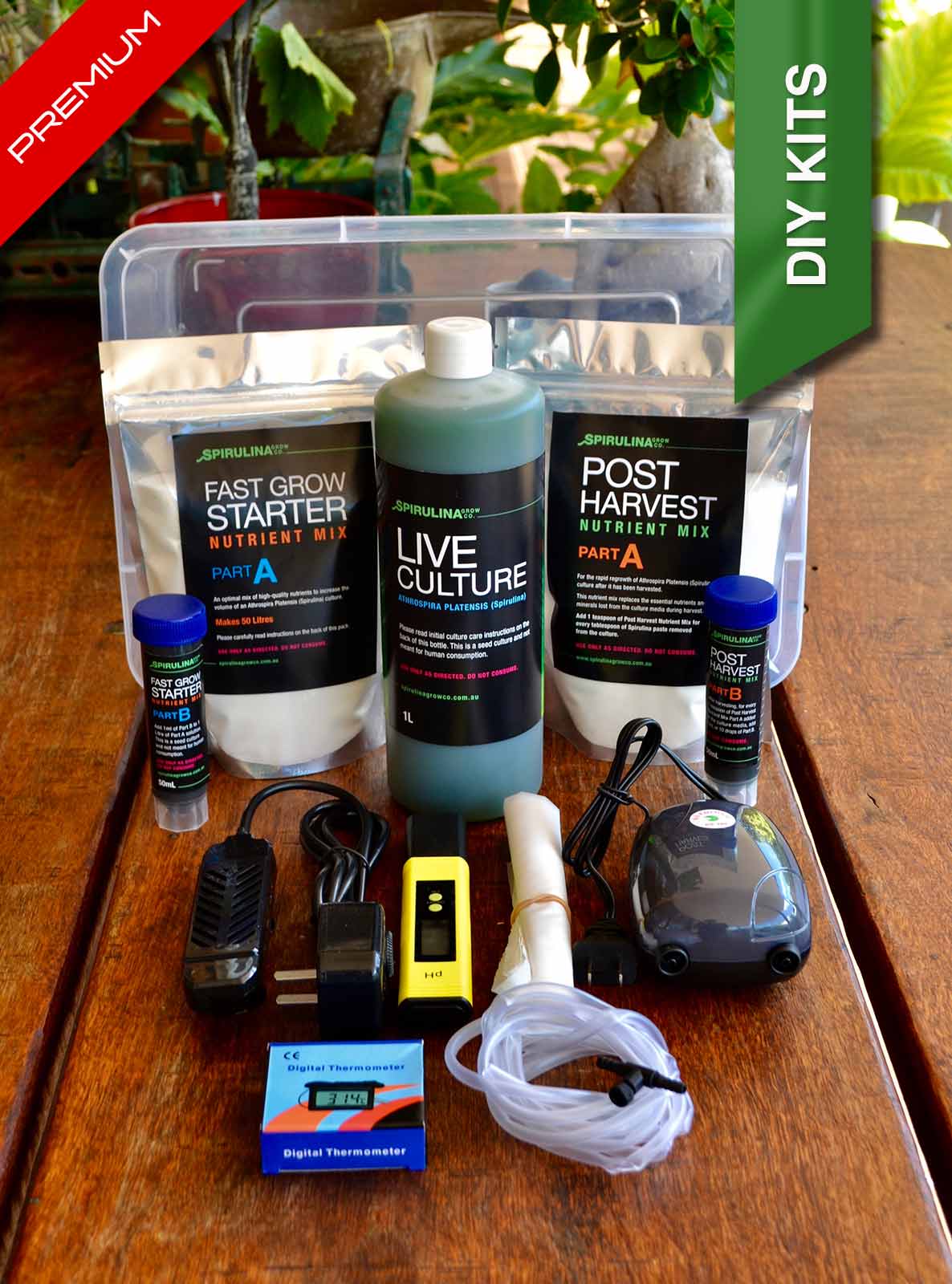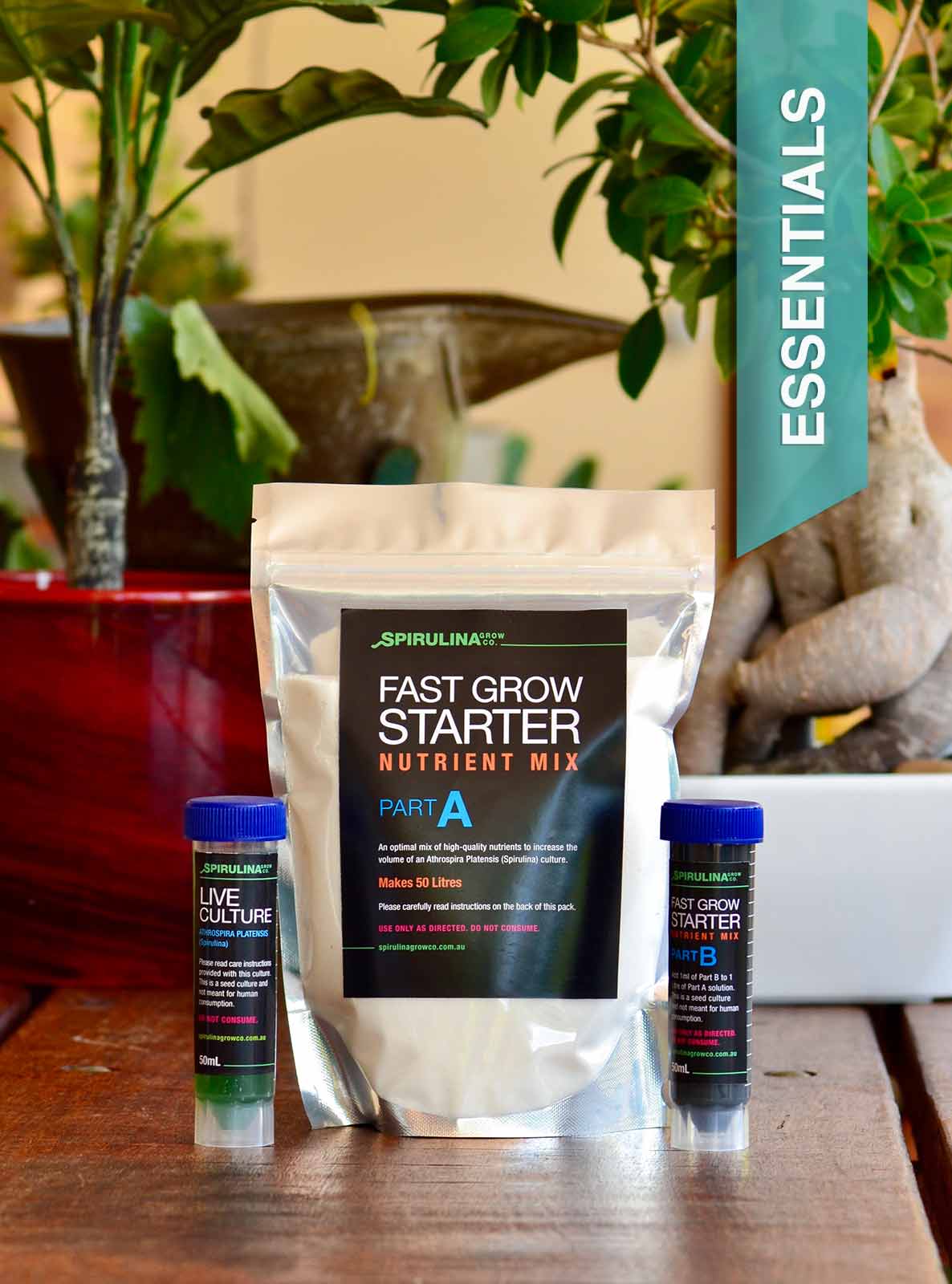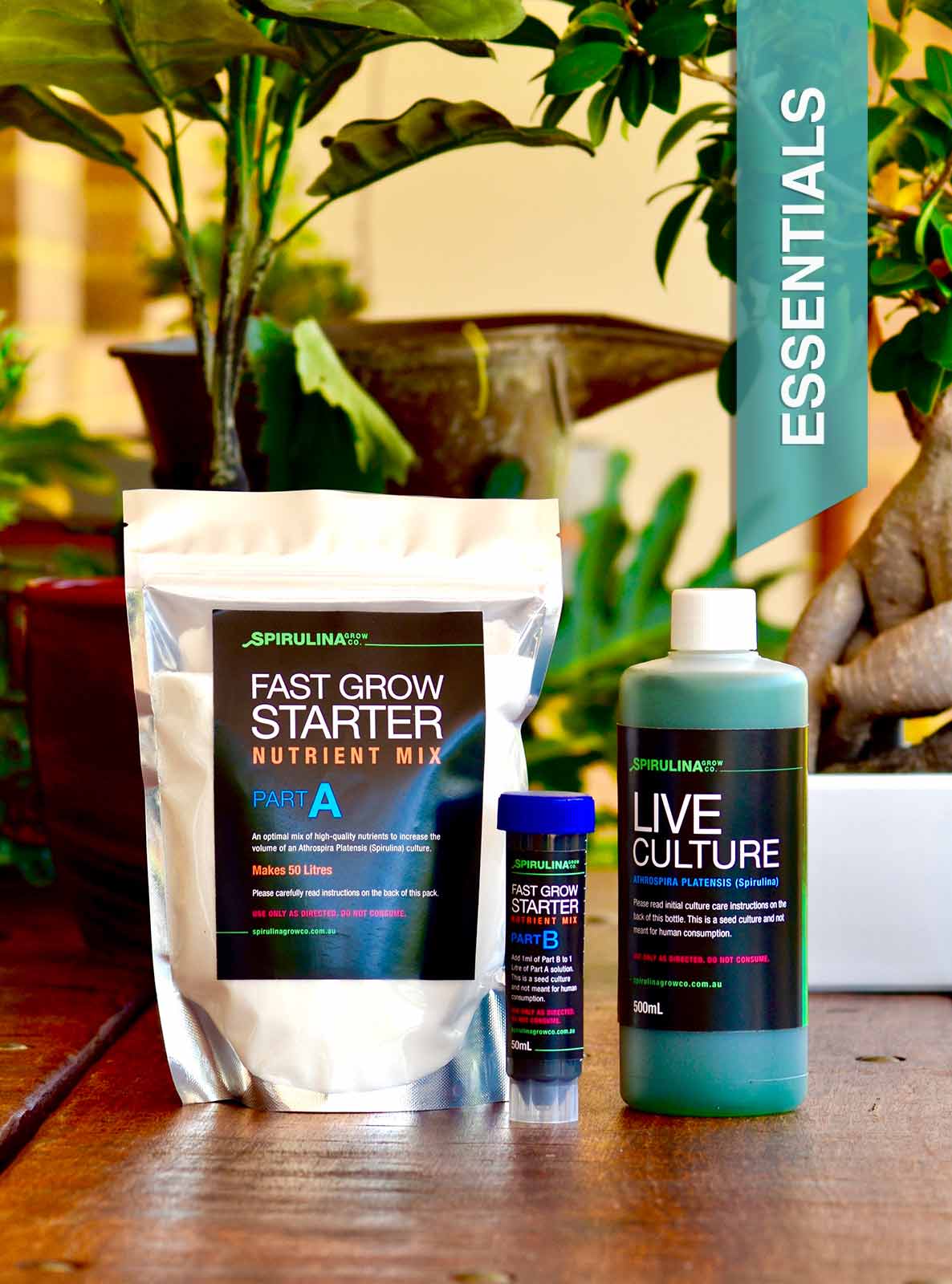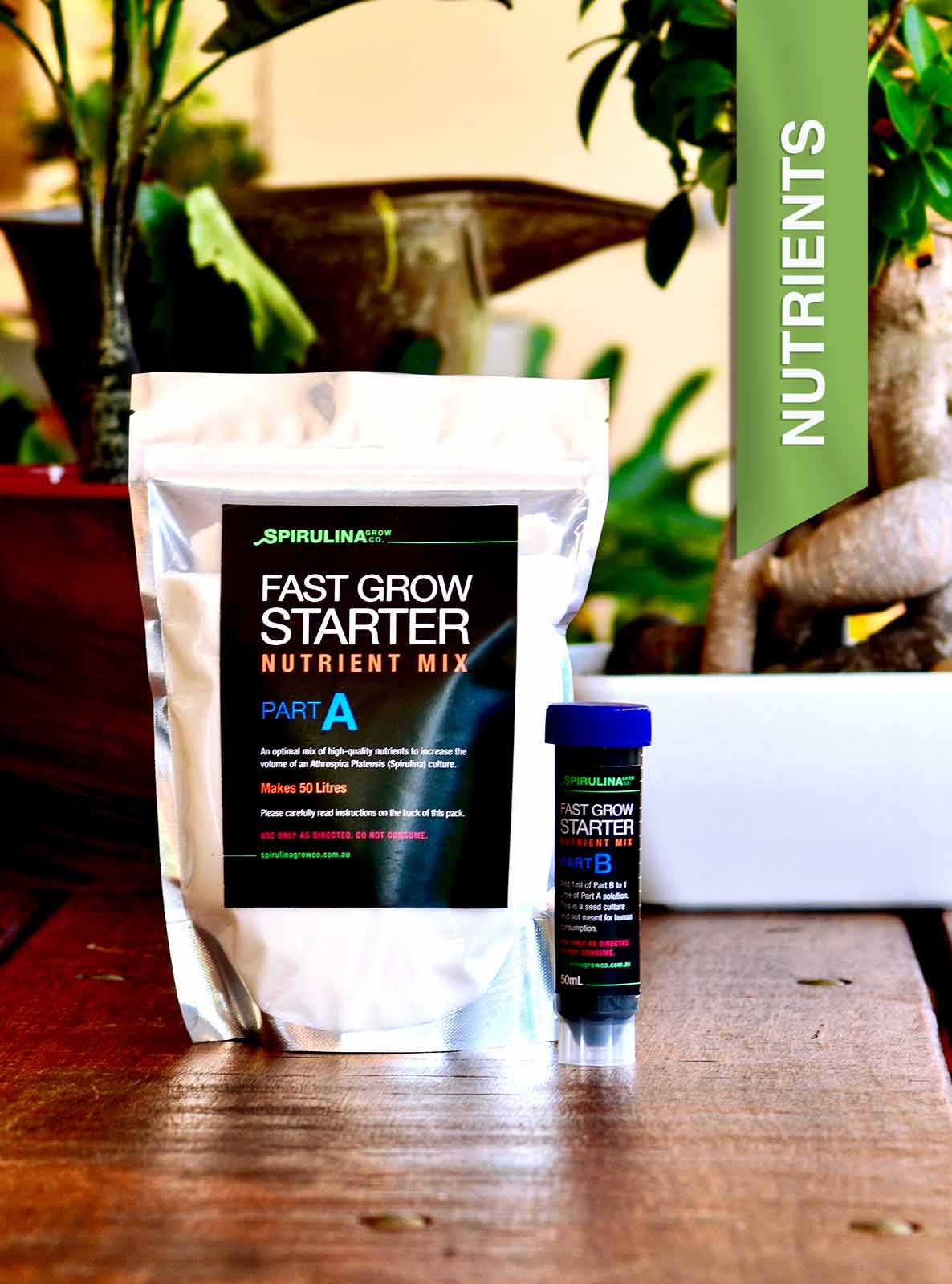FAQ’s – Growing Spirulina

The short answer is “no it is not”
However!
This is a somewhat subjective question depending on what value you put on your health and wellbeing and what you would consider as expensive.
If you buy 1 coffee at $4.00, 5 times a week, then during the course of a year you would buy 260 coffees and spend around $1020. Whereas 260 servings of Spirulina will cost you $14 – $60 depending on how you source the post-harvest nutrients and if, or not, you heat the culture during winter. So, looked at from this perspective, growing your own is not expensive at all.
If you buy dietary supplements, then Spirulina would replace most of them including multivitamins (except for B12). On average Australians spend around $400 per year on supplements. To grow enough Spirulina for one person to have 1 tablespoon of fresh Spirulina per day would cost roughly $20 – $80/year depending on how you source the post-harvest nutrients and, if or not, you heat the culture during the winter.
The figures above do not take into account the initial set up cost. Set up costs will include items like the live culture, nutrients, a bioreactor (aquarium), pump, tubing, harvest mesh, thermometer and pH meter. We sell a kit that has everything you need for $264. This is less than the cost of 2 people going out for a couple of meals.
So when you look at the benefits and the cost, one would have to say it is not expensive.
Like any undertaking, growing Spirulina can take as much time as you want to put into it, but a simple setup takes very little work at all. Spirulina more or less looks after itself. All you need to do is keep an eye on the temperature and pH and general conditions. A couple of minutes a day, no more. Harvesting takes no more than 20mins. Cleaning the tank and changing out the medium every six months or so takes about 90 minutes.
Overall, it is much much less work than a vegetable patch with a higher-value product that you can’t buy at the grocery store!
No. Hardly at all.
Perhaps you have been near a stagnant algae bloom in the wild as it decomposes. This can smell rank. However, a healthy, live Spirulina culture hardly smells at all. In fact, a living blue-green algae culture actually freshens the room it is in by producing oxygen and eliminating carbon dioxide and other pollutants.
A lot!
With commercial powdered, encapsulated or tableted Spirulina:
- Many of the vitamins and phytonutrients are destroyed in the drying process
- They are expensive
- The powder has a strong unpleasant taste which overpowers other flavours – like adding a sardine to your smoothie
- There is a significant risk of heavy metals and contaminants in some brands from certain countries that produce large quantities of Spirulina
- You don’t know what you are eating and what has been added to the commercial product
- Cooking and drying leaves a carbon footprint
On the other hand, with FRESH Spirulina:
- There are a lot more vitamins and phytonutrients available
- It can be added to any food without compromising the taste
- It replaces most expensive vitamin supplements
- There is no risk of heavy metal contamination
- You know what you are eating
- There is a lower carbon and environmental footprint
- It is significantly cheaper than dry products
- You are in control of providing your own vitamin/dietary supplements – not some multinational pharmaceutical company
- It has almost no taste to a very mild flavour that is reminiscent of a sea breeze
- Most would agree that dried Spirulina has a sickening taste – that is why the health food industry sells a lot of Spirulina in capsule or tablet form
- Because fresh Spirulina has almost no taste, it can be eaten straight or added to beverages or cooking without imparting a distinctive flavour
Given Spirulina is the most nutrient-dense food on the planet, you don’t need much at all.
A tablespoon of fresh Spirulina paste a day is plenty.
If the culture is properly set up and fed, its output will be determined by the amount of light the culture receives. In other words, the amount of Spirulina you get is correlated to the area facing the sun multiplied by the number of hours it spends in direct sunshine.
An average output of 25 dry weight grams per square meter per day is about as high as can be expected with an optimal bioreactor design and excellent conditions coupled with lots of sun.
However, what is more typical for Spirulina is about 10 grams per square meter per day under good conditions.
To calculate the area of culture exposed to the sunlight, multiply the length, height and breadth of the sides and top of the bioreactor and add them together.
Five grams per day is a good amount to supplement a human diet. Thus 1/2 square meter with excellent sun is enough to significantly improve the life of one person.
No. Once the pH gets to over 10, no other organism can tolerate the alkalinity. So, while there can be some infection as the culture takes off, once Spirulina alkalizes the media, it kills any other bug that could be harmful to it or you.
No. All you need are a few basic items:
- A transparent container like an aquarium or a plastic storage container
- An aquarium air pump and some tubing
- A thermometer
- A pH meter or litmus paper
- An aquarium heater for cold weather
- Some Spirulina Harvest Mesh
That’s it.
Absolutely. No other nasty micro-organisms can grow at such high pH levels.
Heaps! If you buy culture from us, you are provided with a comprehensive grow manual + you have email support + you will soon have the support of a Facebook grower community.
Remember, growing Spirulina is super easy.
Not much! there are only a few pitfalls that are easy to avoid.
Keep the temperature of the culture over 2 and under 42 degrees Celsius. Under and above these temperatures could result in your culture dying.
Feed your culture after you harvest otherwise it will not regrow.
Only consume once the pH of the culture is over 10, otherwise, you run the risk of eating contaminating organisms. Once the pH gets to 10 and above, most nasty organism die.
That’s basically it. Spirulina has survived for 3.5 billion years – it is a very robust organism.

Premium Spirulina DIY Farming Kit
Premium Spirulina Farming Kit – Everything you need to start!
This Premium Spirulina kit that contains all the essential information, equipment, nutrients and culture needed to start, monitor, maintain and harvest your own Spirulina at home

50ml Spirulina Live and Fast Grow Starter Pack
50 ml live Spirulina culture and Fast Grow starter nutrient pack
The 50 ml live culture and starter nutrient pack together with the instruction manual are the essential components you need to get your spirulina micro-farm established …

Spirulina Live Culture 500ml fast grow nutrient pack Australia
500 ml live Spirulina culture and Fast Grow starter nutrient pack
The 500 ml live culture and starter nutrient pack along with the comprehensive instruction manual contain the essential components needed to get your spirulina micro-farm established.

Spirulina Fast Grow Nutrient Starter Pack Australia
Fast Grow Starter Nutrient Pack For Cultivating your Spirulina
The starter nutrient pack is specially formulated for the rapid and healthy growth of your Spirulina culture. These nutrients are free from contaminants and heavy metals.

